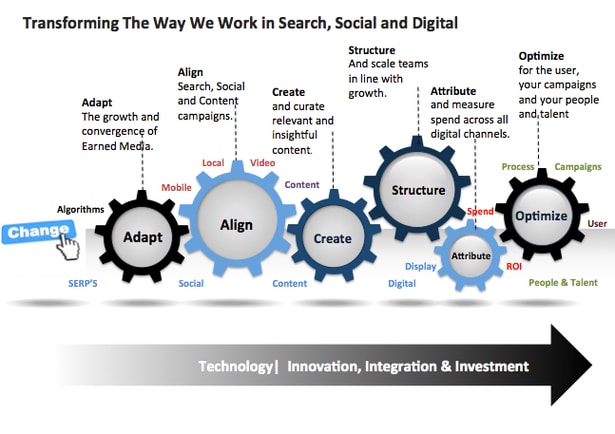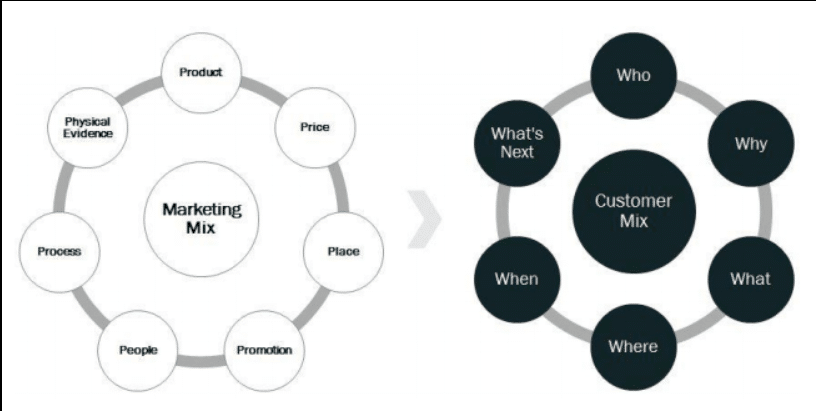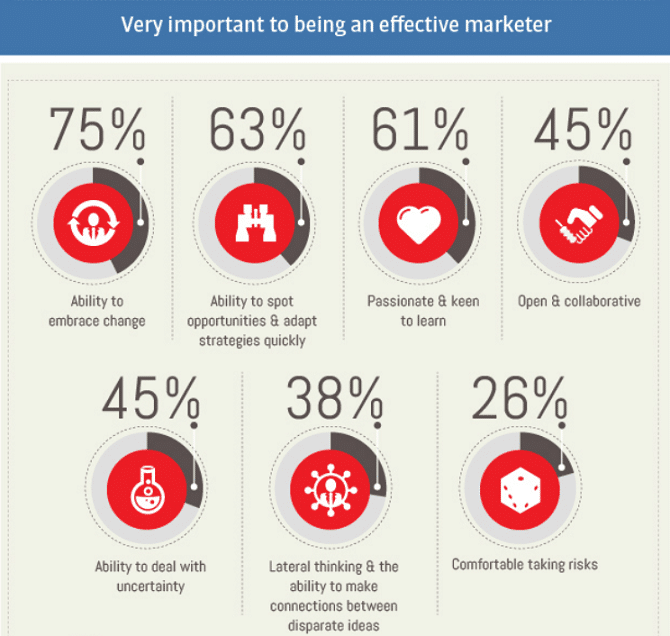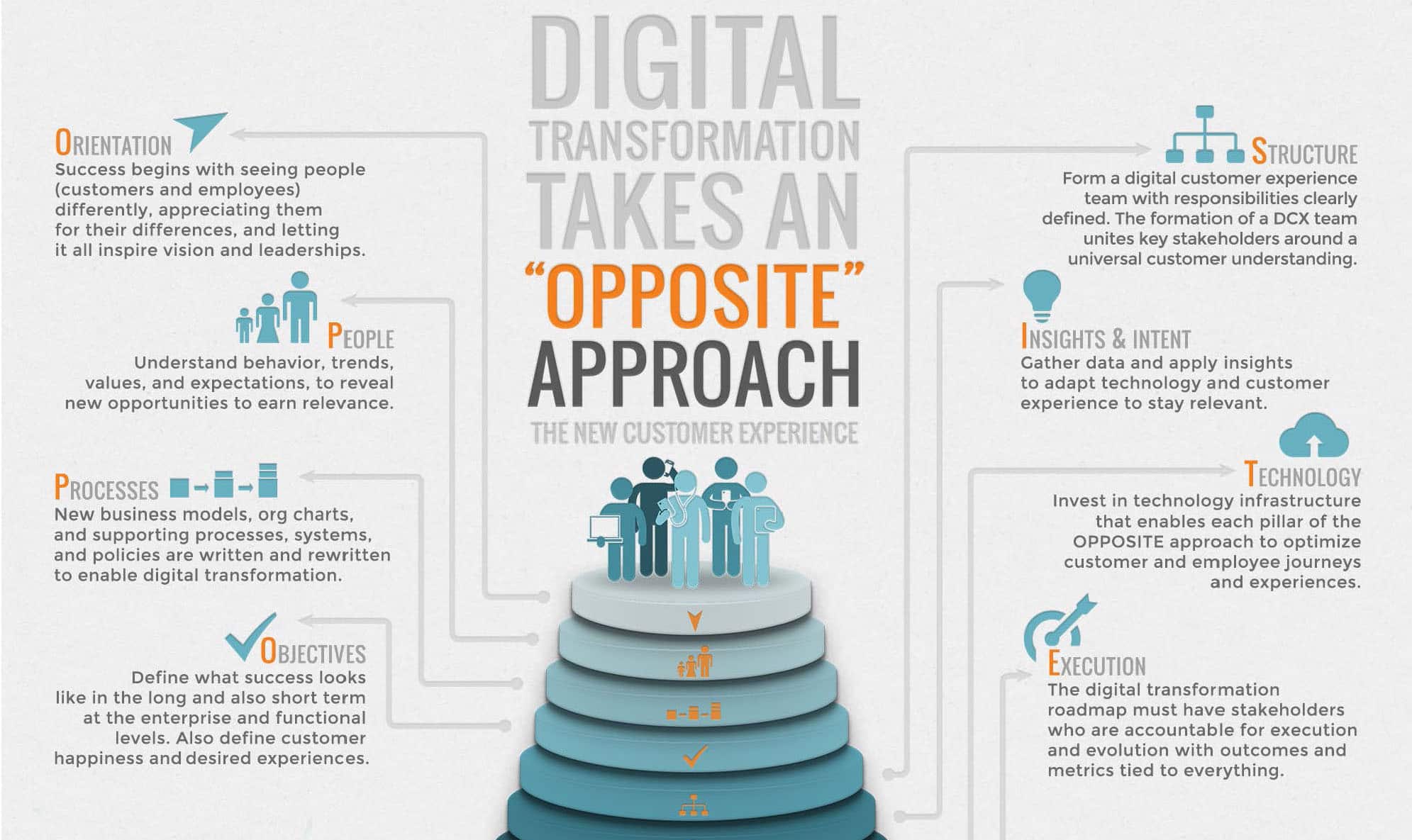
The C-Suite’s Guide to Marketing Transformation
The digital experience is more important no than ever before. The power of Big Data, agile marketing, compelling content strategies, marketing automation, a customer-centric approach – the core tenets of modern marketing weren’t born yesterday.
So, why are some marketing teams struggling to keep up? Difficult times like these will shine a light on a very specific kind of marketing leader. The ones who inspire change across the whole culture.
A full-blown transformation involving an entire team of individuals can be a Mt. Everest-sized obstacle. Throw in problems with corporate management and getting the right employees, and the situation becomes even more pressurized. No wonder the CMO role is known as the most dangerous job title around.
41 percent of all marketers believe C-suite grasps the importance and potential of digital. On the employee side, 48 percent of marketing managers say that retaining good digital employees is a problem. Yet, 99.9 percent of your target audience expects more, the type of ‘more’ that can only be delivered via the power of digital.
Quick Takeaways:
- Marketing is changing but marketers aren’t changing as fast.
- Marketing transformation isn’t just a makeover – it’s a complete “paradigm shift” in strategy and execution.
- The focus of marketing has shifted from the product to the customer.
- The team and the culture of the organization are central to marketing’s ability to evolve and consequently, its success.
- Any transformation must shift your strategy into an agile, data-driven model that anticipates and adapts to market changes.
The (Changing) State of Marketing
Modern marketing transformation is a complete evolution in the marketing landscape. And, it’s not finished evolving. In fact, it’s not going to stop, slow down, or plateau, ever.
In response to the rise of digital, social and mobile technologies, and rapid changes in the way everyone on the planet gets and processes information, governments, businesses and individuals are all facing the challenges of adapting to continuous change.
As organizations seek to differentiate themselves, Marketing has taken on a more prominent role in many organizations. Simple advertising campaigns and tactical approaches to gain new customers are no longer enough. CMOs see the need to define the vision and path to real marketing transformation.
Why? Because business innovation cycles have sped up. Communication happens across the globe in milliseconds Customers expect real-time service and support. All while the global, political and economic landscapes have become more complex. As a result, CMOs need new skills.
(Need help transforming your marketing organization? Contact me today.)
When you look at how comprehensive the shift has been from traditional to modern, it’s no surprise that marketing teams are having trouble. We used to work in a predictable world of investing weeks, if not months, into each campaign. We’d hit the launch button and let go.
Today, it’s a by-the-moment process of development, analysis, and refinement of current campaigns. It’s the sparking of new ideas for what we’ll work on after lunch – not after the holidays – and the ongoing learning of new skills, techniques, and methodologies.
We’ve gone from making a splash with each big unveil to rushing down the gurgling, effervescent river of modern marketing. We’re mobile, social, and agile. Many of us have minimized our advertising – if we’re even using ads at all – having already embraced the more impactful world of content marketing.
Marketing is different now. A new shape, a new mindset. From land-bound caterpillar to see-you-later butterfly. If you want this new creature to thrive, you’ve got to provide the right environment. Culture has to become unbounded.
Enough flowing rivers and fluttering butterflies. What does this look like in real terms? What is the right culture for a powerful, sustainable, modern marketing transformation?
What Is Marketing Transformation?
Marketing transformation means different things to different stakeholders. Simply put, it’s the pursuit of scale, efficiency, and innovation using data and technology to spur profits and growth. Marketing transformation is typically focused on using software to automate and enable streamlined processes.

Adoption of new technologies is often the easy part. However, getting your organization to embrace change is usually more difficult, but necessary for success.
Marketing transformation is a paradigm shift in marketing strategy, structure and systems.
To thrive in today’s rapidly shifting market requires a “paradigm shift” that affects every aspect of your marketing. A marketing transformation requires a radical change in the way you even think about marketing.
To succeed, your marketing transformation must go way beyond buying some cutting-edge tech, slapping a cute little chatbot on your website, and calling it a day.
It must encompass your company culture, a complete reinvention of your operating model, a restructuring of your marketing processes, marketing capabilities that can shift with every change in your market, an omnichannel approach, and to support it all – software as agile as your new organization.
What Happens When Marketing Transforms?
The biggest driver of the evolution of marketing is the consumer. Customer expectations have become more sophisticated. As a response, modern brands need to deliver what the customer wants to remain competitive.
This is true when it comes to both lead generation and customer retention. As a result, we’ve shifted from the marketing mix and the 7 P’s to the customer mix and the 6 W’s. The focus is no longer on what we’re selling but rather who we are selling to.

What is it that customers want?
- They want to plug a search query into Google and get back an answer to their question. The brand websites that have stellar online libraries of SEO optimized content are the ones who are going to capture this search traffic and generate the most leads.
- To pull out their smartphone and look up a recipe on a brand’s website for the product they just bought, or watch a video on how to get the most out of a service they signed up for.
- To contact a brand with a question, comment, or issue through social media, email, or better yet, real-time chat, and have the issue addressed that day.
- A cohesive flow between on-site and online marketplaces.
- Online brand communities where they can see what other consumers are saying about a product or service, hear inspiring stories about how another consumer improved their lives with the product they just bought or are considering, and get expert advice and guidance.
That’s quite a bit more complex than a collection of products and services, along with the billboards, radio ads, online ads, and commercials plastered in as many places as possible to let consumers know those products and services exist.
Both the solution to meeting these needs (and the root cause of the customer expectation revolution) lies in digital.
Digital tools, resources, skills, and the mindset to embrace this new, still largely unchartered territory. This is the foundation of a culture that can withstand a sustainable modern marketing transformation.
Content Is Driving Marketing Transformation
You’ll find that the biggest driver for marketing transformation is your customer. Customers are more sophisticated now than ever, and they do their homework. In fact, 67% of the buyer’s journey is now done digitally.
With your buyer looking for a solution to their problem, you need to supply them with relevant content. The content needs to be informational and helpful rather than sales driven. Decision makers greatly prefer to get information from articles versus advertisers, with 80% saying as much in a survey from the Content Marketing Institute.
In addition to a changing customer, brands have to also deal with a more competitive landscape. It’s likely that all of your competitors are implementing new digital initiatives and trying to take advantage of technology. It’s not a matter of if you’ll transform, it’s when—and that when is now.
Content Marketing Is Central to Marketing Transformation
Your audience craves great content. It’s essential for telling your story in a way that resonates with the right audience. This means you need to have a well-structured content marketing plan in place.
Content marketing is going to be the fuel for your marketing transformation. There are many platforms that enable content marketing like never before, so you don’t have to worry about the manual aspects of publishing, sharing and measuring content.
How Does Content Marketing Enable Marketing Transformation?
One of the tenets of content marketing is understanding your buyer and developing content they want to consume. This means you must stay current on the buyer’s acumen, expectations and preferences.
Advancing your digital transformation efforts requires a strong content marketing foundation. It’s complex, no matter your industry or subject matter. You may also be dealing with a siloed structure where not everyone is on the same page or even knows where the book is.
What you want is to expertly craft and continue to evolve a content marketing plan that delivers an omnichannel experience for your audience. Consider how you can simplify the customer journey through your content marketing objectives. Think about what the buyer gets out of the content and where it leads them on their journey.
This may require dramatic shifts in what you’re doing now, even if you have a content marketing plan. You have to be thinking about how to serve the customer’s needs. On one hand, you need to produce rich, meaningful content. But you also have to make sure technology is part of your plan; otherwise, you’ll fall short on what you do with the content.
Scaling Content Marketing for Marketing Transformation
How scalable is your content marketing plan right now? How much manual work does it take to just get through the process of developing content? What about its distribution and metrics? You can’t scale properly without marketing transformation.
You’ll need a platform that offers you:
- The ability to collaborate and track content from inception to distribution
- Parameters that outline the objectives of the content and the expectations of how readers or viewers will receive it
- Buyer-focused digital guidelines to consider and adopt
Every team or individual involved in the content process should embrace governance, which helps standardize the process. Often, brands develop a playbook that outlines customer requirements across all types of content.
Scalability is vital in marketing transformation. When you have technology that supports scalability, such as Pardot, HubSpot, or Marketo, your content marketing can work harder for you to attract the right customers.
Critical Competencies Required for Marketing Transformation
Caren Fleit and Brigitte Morel-Curran from Korn-Ferry released “The transformative CMO: Three must-have competencies to meet the growing demands placed on marketing leaders.” (No registration required.)
Caren and Brigitte argue that today’s CMO must move beyond brand-building and even voice of the customer to become strategic leaders who carry the weight of delivering quantifiable business results. They must think more broadly than ever before and need the skills (and the relationships) to drive change across the organization. To become a transformative CMO or marketing executives, they believe you need to acquire 3 new competencies:
The report defines the 3 skills required for marketing transformation as:
- Creating the New and Different: more than just the ability to “create new ideas” this skill requires the acumen to manage the innovation process and implement change
- Focusing on Action and Outcomes: requires the ability to make decisions with “incomplete data” that have the largest potential to impact the bottom line.
- Inspiring Others: transformative marketing leaders understand the importance of “compelling vision, commitment, and superior communication” in a diverse work force.
After seeing the report, I reached out to SAP’s CMO, Jonathan Becher (@jbecher) who is leading the marketing transformation effort here at SAP. Jonathan also speaks and writes quite a bit about the need for marketing transformation. Jonathan agreed with the main points of the report but added “the one thing that might be missing is Culture.”
In What Every CEO Should Expect From Their CMO, Jonathan mirrors the need to create “the new and the different” by capitalizing on insights. Jonathan says “For the first time, marketing has the ability to get a view of customers in real time. Jonathan also suggests marketing leaders “inspire others” by not just “representing the voice of the market,” by being “the champion of the overall experience” and the “brand steward” but also by being an “integrator and force multiplier across the company.”
Finally, Jonathan agreed with the need for a “focus on actions and outcomes” in Three Must Dos For The Modern Marketer where he recommends marketers “measure what matters.” Jonathan states “I believe we should track outcome metrics, not activities.”
Start Your Transformation with Thought Leadership
Everything rises and falls on leadership. When you begin such a massive undertaking as a marketing transformation, effective thought leadership is unquestionably the key to success.
The toughest part of marketing transformation, like any other major change, is getting your company to embrace it. An informed, steady leadership team that has the empathy to put themselves into their employees’ shoes during the change is essential for a favorable outcome.
- See things from customers’ perspectives: One of the best ways to begin the conversation is to start with the customers’ perspective. After all, if your company is resistant to change, your customers will begin to drop off as other businesses begin to meet those customers’ needs
- Use well-researched articles, videos, and other content to convince resisters to support the transformation: To explain these hard facts to resistant staff members – especially if some of them are in the C-suite – some internal content marketing goes a long way toward establishing your expertise in knowing what your customers will demand. Since 82 percent of decision-makers feel more positive about an organization after reading well-researched content, this step, though time-consuming, will prove well worth the effort when you bring your staff on board with this crucial change.
- Look for inspiration from others like the stories and stats I shared in this international marketing transformation keynote:
Next, Transform Your Corporate Culture
Your marketing transformation won’t work if your company continues with a traditional corporate culture. Two factors common to traditional corporations can put a wrench in the works of your marketing transformation: top-down leadership structure and departmental silos.
- Top-down leadership: With the requirement for fast decisions and abrupt direction changes mid-campaign when the data indicates the need, waiting to hear from the stodgy suits upstairs before you can switch gears takes time–time you don’t have. Until you can get leadership on board to trust your teams to make decisions on the fly, you won’t have the kind of agility that data-driven, rapidly changing marketing requires.
- Siloed departments: When your sales team has little idea about what your marketing team is doing, they won’t have access to the data that indicates that a new market of eager customers has just opened up for that new widget they’re trying so hard to sell. They won’t know that 50 percent of the executives who read your latest blog post downloaded the white paper that positioned the new widget as the solution to one of their critical challenges. Similarly, your marketing team won’t have access to the feedback your field reps hear–so you can accentuate the features customers like best in your next campaign.
Key Features of a Modern Marketing Culture
So, how can today’s marketing managers facilitate this type of digital-friendly culture?
- With an evolved team structure. Modern marketing will have difficulty working in a traditional hierarchical culture. When creative, innovative ideas are a marketing team’s strongest asset, the most successful marketing teams are the ones that embrace input, communication, and collaboration in an environment that fosters workplace equality.
- With evolved skills. The right culture will look for people who have the skills that are necessary for a strong digital marketing team. Individuals who specialize in SEO, content management, website maintenance, copywriting, social media, data analytics, event planning, mobile strategy, graphic design, and lead nurturing are all important. A lot of the next-generation marketers are proficient in several skills and are hybrid professionals. Modern marketing agencies and managers are also filling skill gaps by outsourcing. From video production to coding, today there is such a breadth of essential skills. Few marketing teams are going to have someone who is strong in every area.
- With an evolved mindset. A modern marketing culture embraces an entirely different set of values. Taking initiative, asking questions, disruption, a willingness to try something, fail, and learn – these are the ingredients that go into a strong, agile marketing team that can live up to the modern consumer’s evolving expectations.

Dr. Tim Sparkes, business psychologist of Hudson Talent Management explains this mindset shift well:
“With every indication that the workplace will continue to accelerate and fragment, mindset is entering center stage in defining talent for an unknown future. Of course, skills are crucial to do a job but identifying individuals with the right mindset to navigate business transformation and disruption, and to quickly learn and deploy new skills will – or already is – the key to competitive advantage in a world that is volatile, uncertain, complex and ambiguous at its heart.”
Use Data and Storytelling to Sell Your Transformation
Before you undergo your digital transformation, you’ll need to present some hard data to the skeptics. When you set that data into stories that show how a transformation of the way they do marketing has helped other companies like yours soar to success, they’ll be more likely to say “yes” to the changes.
It’s hard to argue with the numbers. As you make the changes that will eventually lead to your total marketing transformation, keep track of the metrics. When you see positive changes in revenue, social media likes, downloads, or subscribers, don’t keep the news to your department only.
Those changes will include more insights into your customer base. Use every digital tool at your disposal to view their experience from their perspective. Use AI and other cognitive technologies to predict when customers will encounter problems, and then be ready to solve those problems with the content, products, and services that will make their lives easier, as AdAge’s Shiv Singh advises.
Use the same content marketing skills that you use to promote your products’ benefits to tell your success story to the whole company. Don’t limit your stories to the marketing department. Find marketing transformation success stories throughout the company to build a passion for change throughout your entire organization.
Once You Have Set the Stage, Follow a Logical Plan
No matter how glamorous the glory days of Madison Avenue sound, you wouldn’t dream of going back to doing marketing the way they did it: glitzy, kitschy commercials that blanketed the airways – all three of them.
Back then, with only three TV networks and a few magazines that everyone read, you could just “spray and pray” your ads and count on revenue pouring in. But, in today’s world, if you haven’t transformed your marketing strategy much beyond a few tweaks to your SEO every time Google updates its algorithms, you’ll fall behind your competitors. In today’s world of digital everything and cognitive computing, you need a total marketing transformation to stay ahead of your competition.
So what’s the plan?
- Assess the current state of your marketing strategy: If you don’t know where your strategy is now – what it has accomplished and what it hasn’t – you won’t know how to recognize success when you see it.
- Choose your goals: What is your vision for what you want your marketing transformation to accomplish?
- Set a strategy to get there: Create a marketing roadmap that will provide you and your teams a step-by-step guide that helps you accomplish all your goals.
- Decide what processes to use: Lay out the processes to get to each step in your transformation strategy:
- Choose what metrics are most important: For B2B companies, often leads are a better metric of marketing success than customers. Each business has its key performance indicators (KPIs) that it must keep track of for a truly effective transformation.
- Decide which technology platforms to use: With a wealth of marketing software on the market, it’s important to research which tools will help your company achieve its goals.
- Governance and control: Set the policies for each team so they know what decisions they can make on their own. With firm policies that provide guidance, decisions become easier to make, and management gains more trust in the abilities of its teams to make those decisions.
- Choose which partners you want to work with: Many companies prefer to outsource at least some of their marketing to a specialized agency. Whether it’s content marketing, graphic design, or marketing technology (martech), outsourcing or partnering with another company to achieve your goals might yield the most return for your investment.
When you prepare your company from top to bottom to welcome a transformation in the way you do marketing, setting all the machinery in motion to achieve needed change will go more smoothly. Follow your transformation roadmap, and marketing success will come your way.
The Opposite Approach to Digital Transformation
For marketers who are looking to lead change within their organization, where do they start? Altimeter Group interviewed executives from 32 industries undergoing digital transformation at their companies, to better understand the journey they are taking towards success. And they learned that successful marketers lead their efforts with an “O.P.P.O.S.I.T.E.” approach.

OPPOSITE is an acronym that represents eight best practices and steps that help brands jumpstart their digital transformation efforts, to bring your teams together and work towards a relevant, compelling customer experience. Let’s take a closer look at each stage:
1. Orientation
The first step to successful digital transformation starts with establishing a new perspective to drive meaningful change. All stakeholders and teams involved must first shift how they see, understand and appreciate customers and their expectations, preferences, behaviors, values and other factors that may impact their actions.
Change can be scary and undesirable for many leaders, particularly when they lack a clear view of the changing customer behaviors and trends that are reshaping the market. Success begins with helping executives and other change agents understand the need to take action even in the absence of a complete customer picture, and start establishing this view and perspective with the data and insights you have. Look at both current and emerging trends and how they compare to your brand’s existing roadmap.
2. People
The second stage involves discovering and understanding your customer values, behaviors and expectations. These customer insights will help reveal opportunities to deliver a more compelling, relevant experience throughout the customer journey.
Step into your customers’ shoes and start mapping the customer journey and identifying touchpoints that are missing or could be improved on. Then design a customer experience strategy that leverages your existing journey as well as the research, trends and insights you’ve gathered.
Beyond research, journey mapping and data, consider conducting customer interviews to help you better understand your target audience and guide your investments in a new customer experience that truly meets the needs of your target audience.
Your work must take into account your customers’ intentions, desired outcomes and behaviors at each touchpoint on different devices. All touchpoints must be seamlessly integrated to deliver a desirable, smooth experience throughout the customer journey for all devices.
3. Processes
As the next step, conduct an audit of your existing business models, processes, policies and systems to determine the roadblocks that may get in the way of your transformation efforts. Revise or write new policies, processes and models that will drive forward the new direction and scale.
At some point of the digital transformation journey, Altimeter Group found that companies will reach the point of scale that requires governance work to standardize and manage the new processes, policies and systems. This work will be performed by a cross-functional committee supported by executive sponsors.
The workgroup’s planning and collaboration efforts overtime will lead to the development of interim structures supporting pilot programs and changes to existing departments and teams. New models will be established to continue to scale and enhance the transformation journey and customer experience.
4. Objectives
In this stage, you’ll define the goals for digital transformation and why the new customer experience is critical to driving value for all stakeholders and shareholders. When setting your objectives, make sure they align with both your short and long-term milestones relevant to the customer experience.
Every initiative you execute at each phase of the journey must map back to your goals, and all teams involved in the transformation efforts must be held accountable. As well, it’s important to determine in this stage how progress and success will be measured, and the steps to get there.
Document your transformation efforts in intervals, ranging from six months to the next five years, so your workgroup and stakeholders can see what they are working towards and how they can translate the accomplishment of key objectives into additional budgetary support and resources.
5. Structure
With a transformation workgroup established in step three, in this stage you’ll form a dedicated customer experience team by uniting all key stakeholders, in various departments and roles within your organization, responsible for managing different touchpoints of your customer experience. This ensures everyone shares a universal understanding and goal when it comes to their customers.
While the transformation workgroup and customer experience team regularly work together, they serve different purposes. The transformation workgroup oversees transformation at the executive level, and the customer experience team manages the transformation efforts across different departments.
Ownership is one of the biggest challenges marketers and their brands face with digital transformation, and establishing these two committees will help manage those pain points. Successful transformation involves defining and assigning roles within each workgroup to avoid confusion and to drive change efficiently. These responsibilities are often based on the RA(S)CI process model: Responsible, Accountable, Supported, Consulted, Informed.
6. Insights And Intent
It’s important to conduct research and gather data throughout the transformation process. This helps to develop an informed strategy that optimizes and reiterates the evolving customer experience, which adapts to changing technology and consumer behaviors, trends and expectations.
Research is of limited value and use if the data is not analyzed and translated into actionable insights. You need to look at the context, device, intent and behavior behind your customer data and research. Some questions to ask include: Why did this transaction occur? What were the customer’s intentions and motivations? What device did they use? What are the events that will occur as a result of this transaction?
7. Technology
The OPPOSITE approach requires one to think about the role technology plays in the customer journey and experience, so collaboration with IT is crucial. While it is not an end-all solution to all your customer experience challenges, technology plays an important role in that it helps you reach your transformation goals by enabling and facilitating seamless, personalized and cross-channel customer engagement.
All IT departments have their own technology roadmaps to modernize and upgrade existing infrastructure, so you must work together to determine whether all legacy investments and plans can support the company’s transformation efforts or not. If outdated or misaligned, they must be updated so the roadmaps align with and support your digital transformation and customer experience work.
It’s important to fight the “shiny object syndrome” and not fall for the latest systems and platforms for their novelty. Instead, you need to select technology solutions that will help you solve your current challenges and create opportunities at each stage of the OPPOSITE framework.
8. Execution
Execution of your transformation strategy is as important as the vision that leads it. Since your transformation efforts require heavy investments of resources and time, execution should be broken into tangible, attainable steps, with related metrics and KPIs that you can measure progress against over time to validate your work.
Even the smallest pilot programs can have big impacts on your company’s path to digital transformation maturity. So it’s important that all key leaders and change agents driving the transformation are committed to learning and sharing best practices with one another, to continuously improve your brand’s digital transformation and customer experience.
What Do You Do Now?
All marketing teams are changing. There’s not a CMO out there who denies digital or is still drumming up support for a major print ad campaign, at least without it being nothing more than a fragment of a holistic digital-traditional strategy. But not all marketers can go with the flow of the modern, digital, customer-centric reality.
If you want to get from point A to point B, from traditional to modern (and good at it), don’t take a linear approach. Don’t move towards point B, hitting your goal posts along the way. You’ll never get there. Transform point A into point B. Change your culture. Change the way your team interacts with one another. Bring in new talent and help your current employees take on new skills. And, consciously align values and mindset with this brave new marketing world. That’s how you make space for point B to evolve.
Maybe culture, innovation or the challenges of modern marketing transformation is something I can help you with? I’ve helped dozens of companies, I’ve helped activate hundreds, even thousands of thought leaders. I’ve done it for numerous clients. And I can do it for you. Contact me today!






